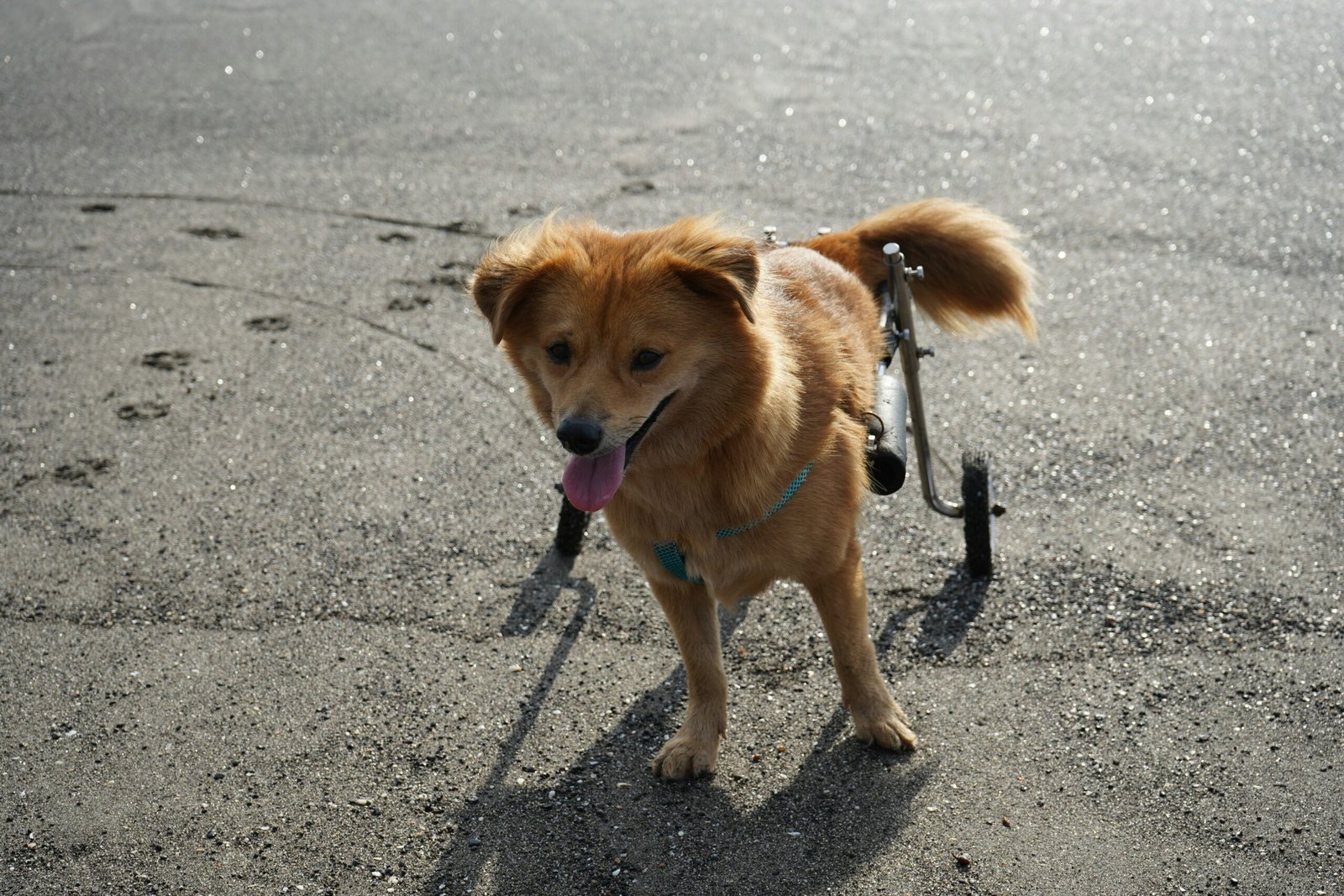Introduction
If you’ve ever searched for how to help senior dogs with arthritis at home, chances are you’ve seen your loyal companion struggling with stiff joints, slower walks, or hesitation on the stairs. Arthritis is one of the most common health challenges older dogs face, and while it can’t be cured, the right at-home care can make a world of difference.
Imagine your dog waking up less stiff in the morning, moving more freely, and even showing sparks of their playful personality again. With simple lifestyle changes, natural home remedies, and the right supplements, you can reduce their pain, protect their joints, and give them the comfort they deserve in their golden years.
In this 2025 guide, we’ll walk you through practical, vet-approved ways to manage arthritis at home — from orthopedic beds and gentle exercises to supplements like glucosamine, omega-3s, and CBD. You’ll also discover real pet-owner success stories, and when it’s time to seek veterinary care for extra support.
This post may contain affiliate links. If you buy through these links, I may earn a small commission at no extra cost to you. As an Amazon Associate, I earn from qualifying purchases.
Table of Contents
Understanding Arthritis in Senior Dogs
Arthritis in senior dogs is one of the leading causes of pain and reduced mobility. It happens when the protective cartilage in the joints wears down over time, leading to stiffness, swelling, and discomfort. While arthritis is most common in older dogs, large breeds and very active dogs may show symptoms earlier.
Common Symptoms of Arthritis in Dogs
- Stiffness after resting – your dog may struggle to get up after naps or appear sore in the mornings.
- Limping or favoring one leg – especially noticeable after exercise or long walks.
- Difficulty with stairs or jumping – senior dogs may hesitate to climb stairs, get on the couch, or into the car.
- Slower movement – shorter walks, lagging behind, or a general loss of enthusiasm for play.
- Behavioral changes – irritability, reluctance to be touched, or decreased activity.
Breeds More Prone to Arthritis
While any senior dog can develop arthritis, it’s especially common in:
- Large breeds like German Shepherds, Labradors, and Golden Retrievers.
- Overweight dogs, where excess weight increases joint stress.
- Active or working dogs with years of wear and tear.
Why It Matters
Arthritis isn’t just about stiff joints — it impacts a dog’s entire quality of life. Without proper care, dogs can lose mobility, independence, and even confidence. But with early recognition and consistent at-home support, you can help manage symptoms and keep your dog comfortable for years to come.
Simple At-Home Care for Senior Dogs with Arthritis
You don’t need to be a vet to make your arthritic dog’s life more comfortable. Small changes at home can ease joint pressure, reduce pain, and improve mobility. The goal is to remove obstacles, provide comfort, and support your dog’s aging body in ways that keep them moving without strain.
1. Provide a Supportive Bed
Senior dogs need more than a soft blanket on the floor. An orthopedic dog bed with thick memory foam cushions painful joints, reduces pressure points, and helps your dog stay warm throughout the night. For dogs that toss and turn, beds with bolstered sides can provide extra support for the neck and spine. Choosing a washable cover also makes cleaning easier, which is important for older pets that may have accidents.
➡️ Many owners see big improvements with Amazon orthopedic beds designed for dogs with arthritis.
2. Use Ramps Instead of Stairs
Climbing stairs or jumping onto furniture can be especially painful for senior dogs. Lightweight, portable dog ramps or steps give your dog safe access to couches, beds, and cars. Look for ramps with non-slip surfaces to prevent falls. This simple change takes stress off their hips and knees and helps them maintain independence longer. Amazon dog ramp for at home.
3. Keep Their Sleeping Area Warm
Cold, damp environments make arthritis symptoms worse. Keep your dog’s bed away from drafts or hard flooring, and consider placing it in a cozy corner of the house. Heated pet pads or self-warming mats can be especially soothing in winter, easing stiffness and helping your dog relax.
4. Gentle Massage & Heat Therapy
Soft massages around stiff joints improve circulation, reduce swelling, and help relieve muscle tension. Start with light pressure and see how your dog responds. You can also use a warm compress or a heating pad (set on low and never left unattended) to target stiff areas after naps or exercise. Just 10–15 minutes can make a noticeable difference.
5. Keep Nails Trimmed
Overgrown nails force your dog to shift their posture, which increases stress on already aching joints. Keeping nails short allows your dog to walk more naturally, with less strain on their legs and hips. If trimming is difficult at home, many groomers and vets offer quick nail care sessions.
Pro Tip: Think of these steps as “arthritis-proofing” your home. Just like you’d adapt a house for an aging family member, these small changes can dramatically improve your senior dog’s comfort and mobility.

The Role of Diet & Supplements
When it comes to managing arthritis in senior dogs, diet plays a crucial role. What your dog eats every day can either reduce inflammation and support joint health — or make stiffness worse. Adding the right supplements can make a noticeable difference in mobility, comfort, and overall quality of life.
1. Glucosamine & Chondroitin
These are the most trusted joint-support ingredients for dogs. Glucosamine helps rebuild and protect cartilage, while chondroitin keeps joints cushioned and flexible. Together, they not only support mobility but also slow down further cartilage breakdown, which is key for dogs with arthritis. Vets often recommend them as the foundation of any joint-support regimen.
➡️ Trusted options like Cosequin or Dasuquin (Amazon) are widely used by veterinarians.
2. Omega-3 Fatty Acids
Omega-3s from fish oil are powerful natural anti-inflammatories. They can reduce swelling, ease stiffness, and improve mobility over time. In addition, omega-3s contribute to heart health, brain function, and shiny coats, making them a multi-benefit supplement. Many senior dogs that struggle with dry skin or dull fur see improvements after consistent use.
➡️ Available as stand-alone oils or included in premium supplements like Innovet Pets Advanced Mobility Chews.
3. MSM (Methylsulfonylmethane)
MSM is a natural compound with anti-inflammatory and antioxidant properties. It works well when combined with glucosamine and chondroitin, helping reduce joint pain and supporting overall mobility. Beyond arthritis, MSM may also help with muscle recovery after walks and play, making it easier for older dogs to stay active. Its detoxifying qualities are an added bonus for long-term health.
4. CBD for Arthritis Relief
CBD has quickly become a popular option for managing pain and inflammation in senior dogs. It works with the body’s endocannabinoid system to provide relief without harmful side effects, unlike some long-term medications. Many owners report seeing their dogs move more freely, sleep better, and even regain interest in play after adding CBD. Since it also supports anxiety relief, it can be a great all-around supplement for aging dogs.
- King Kanine King Kalm CBD Oil (CBD + krill oil for joint and anti-inflammatory support).
- Nuleaf Naturals CBD Pet Oil (clean, natural formulation).
- Bailey’s CBD Dog Chews (tasty daily option for both pain relief and calming).
5. Weight Management
Excess weight puts extra pressure on already sore joints. Feeding a high-quality, balanced diet that maintains a healthy weight is just as important as supplements. Even a few extra pounds can make arthritis symptoms significantly worse, especially in large breeds. Many senior dog formulas are lower in calories but still nutrient-dense, helping dogs feel full without adding strain on their joints.
Vet Tip: Supplements work best when used consistently. They’re not a quick fix — but with daily use, many senior dogs show noticeable improvements in 4–6 weeks.
Gentle Exercise & Physical Therapy
Keeping your senior dog active may seem counterintuitive when they have arthritis, but regular, low-impact exercise is essential for joint health. Gentle movement strengthens muscles around the joints, improves circulation, and helps maintain flexibility — all of which reduce stiffness and pain over time.
1. Short, Frequent Walks
Instead of long, strenuous walks, take your dog on short, consistent strolls throughout the day. These walks keep joints lubricated and muscles strong without overtaxing painful areas. Gradually increase distance or pace as your dog’s comfort improves, and always monitor for signs of fatigue or limping.
2. Swimming & Hydrotherapy
Water supports your dog’s weight, reducing joint stress while providing a full-body workout. Swimming or walking in a shallow pool can improve flexibility, tone muscles, and help older dogs stay active even if they struggle with land-based exercises. Many rehabilitation centers offer canine hydrotherapy, but small, supervised sessions at home can also be beneficial.
3. Gentle Stretching
Just like humans, dogs benefit from stretching exercises to maintain range of motion. Focus on slow, gentle stretches of the legs, shoulders, and hips, holding each for a few seconds while watching your dog’s comfort level. Stretching before walks or after naps can make a noticeable difference in mobility over time.
4. Physical Therapy Aids at Home
Simple tools like balance cushions, low steps, or wobble boards can encourage safe movement while strengthening stabilizing muscles. These exercises also challenge joints in a controlled way, which can help reduce pain over time. Always supervise your dog and start with short, low-intensity sessions.
5. Avoid Overexertion
While exercise is important, it’s equally crucial to avoid pushing your dog too far. Overexertion can worsen inflammation and trigger flare-ups. Watch for limping, whining, or slowing down, and end sessions immediately if your dog seems uncomfortable.
Vet Tip: For dogs with advanced arthritis or mobility issues, professional physical therapy may include massage, laser therapy, or underwater treadmill sessions. Even at home, gentle, consistent movement combined with supplements can significantly improve comfort and quality of life.

Creating a Comfortable Home Environment
Your senior dog’s home should feel like a safe, supportive space that minimizes stress on aching joints. Simple changes can make daily life easier, reduce pain, and encourage your dog to move more freely throughout the house.
1. Non-Slip Surfaces
Slippery floors can cause falls and increase joint stress. Adding non-slip rugs or mats in high-traffic areas — like the kitchen, hallway, or near stairs — helps your dog maintain balance. This not only reduces the risk of injuries but also encourages your dog to move confidently throughout the house without hesitation. Over time, your dog may even regain more natural walking patterns thanks to the added traction.
2. Raised Feeding & Water Bowls
Bending down for meals can be uncomfortable for dogs with arthritis. Elevated food and water bowls allow them to eat and drink without straining hips, shoulders, or neck. This adjustment can help reduce post-meal stiffness and make mealtime more enjoyable. Many senior dogs show improved posture and less joint discomfort just a few days after switching to raised bowls.
➡️ Options available on Amazon.
3. Accessible Sleeping Areas
Avoid forcing your dog to climb stairs or jump onto furniture. Provide orthopedic beds in quiet, easily accessible areas of your home. Beds with memory foam or bolsters help cushion sore joints and provide extra support for hips, elbows, and shoulders. Heated beds or self-warming mats can be especially soothing for arthritic dogs during colder months, easing stiffness and encouraging longer, restful sleep.
➡️ Examples: Amazon orthopedic beds.
4. Ramps & Steps for Furniture
Instead of jumping, allow your dog to use small ramps or pet stairs to access couches, cars, or beds. This reduces the strain on hips and knees while preserving mobility. Using ramps consistently can also prevent sudden injuries caused by awkward landings. Over time, your dog may gain confidence moving independently around the house without fear of pain. Check out this Bestseller on Amazon.
5. Temperature Control & Comfort
Arthritic dogs are sensitive to cold and damp conditions. Keep sleeping and resting areas warm and dry, and consider using heated pads or blankets during winter months. Maintaining a consistent, cozy environment helps reduce stiffness, encourages movement, and supports overall comfort. Dogs tend to be more active and playful when they’re not battling the cold or aching from chilly floors.
6. Reduce Environmental Stressors
Clear pathways of clutter, cords, or obstacles that could trip your dog. Minimizing situations that require sudden bursts of movement — like chasing toys or dodging other pets — protects sensitive joints. A calm, organized environment also lowers stress, which can improve your dog’s mood and willingness to exercise. When hazards are removed, your dog feels safer exploring the house and maintaining activity levels.
Pro Tip: Think of your home like an arthritis-friendly zone. Even small adjustments — a ramp here, a rug there, a warmer bed — can dramatically improve your senior dog’s daily comfort, mobility, and overall quality of life.
When to Consult a Veterinarian
While at-home care can significantly improve your senior dog’s comfort, veterinary guidance is essential for managing arthritis safely and effectively. Knowing when to seek professional help ensures your dog doesn’t suffer unnecessarily and receives the best long-term care.
1. Sudden Worsening of Symptoms
If your dog’s limping, stiffness, or pain suddenly worsens, it may indicate an injury, infection, or flare-up that requires veterinary attention. Don’t wait for it to resolve on its own — early intervention can prevent further joint damage. A vet can perform a physical exam and recommend pain management or imaging if needed.
2. Severe or Constant Pain
Signs of ongoing pain include whining, reluctance to move, loss of appetite, or unusual aggression. Constant discomfort is not normal and should never be ignored. Your veterinarian can prescribe appropriate pain relief or adjust your dog’s supplement regimen to improve comfort safely.
3. Difficulty with Daily Activities
If your dog struggles to climb stairs, jump onto furniture, or even stand after resting, it’s time for a professional assessment. A vet can evaluate the severity of arthritis, recommend low-impact exercise routines, or suggest physical therapy to restore mobility. Early intervention can preserve independence for longer.
4. Considering Prescription Medications or Advanced Treatments
Some senior dogs may need NSAIDs, corticosteroids, or other prescription therapies to manage inflammation and pain. A vet can determine the safest options and monitor for side effects. Advanced treatments such as laser therapy, joint injections, or hydrotherapy may also be recommended for severe arthritis cases.
5. Regular Check-Ups for Ongoing Management
Even if your dog is responding well to home care, schedule regular vet visits to monitor joint health. Adjustments in diet, supplements, or exercise may be needed as arthritis progresses. Consistent veterinary oversight ensures your dog remains comfortable, active, and pain-free for as long as possible.
Vet Tip: Combining at-home care — like orthopedic beds, ramps, gentle exercise, and joint supplements — with professional guidance gives your dog the best chance for sustained comfort and mobility.
Real-Life Story: How Home Care Transformed Max’s Life

Max, a 10-year-old Labrador, had always been energetic, but arthritis gradually stole his spring. He started struggling to climb the stairs, hesitated jumping into the car, and his walks became shorter and slower. His owners were worried, but with consistent at-home care and targeted supplements, Max’s quality of life improved dramatically.
The At-Home Changes
- Orthopedic Bed: Max began sleeping on an KOPEKS Jumbo Orthopedic dog bed, reducing pressure on his hips and elbows. Within a week, he was standing up more easily and seemed less stiff in the mornings.
- Ramps & Steps: Small ramps allowed him to safely get onto furniture and into the car without jumping, which eased strain on his joints.
- Supplements: Daily glucosamine + chondroitin chews and King Kanine CBD Oil helped reduce inflammation and improve mobility. His owners noticed that Max was moving more freely within 4–6 weeks.
- Gentle Exercise: Short, frequent walks and mild stretching exercises kept his muscles strong and joints lubricated without overexertion.
The Result
After just a few months, Max regained confidence in walking, playing, and even climbing the stairs again. His owners describe him as “happier, more comfortable, and back to his old self in small but meaningful ways.”
Takeaway: Max’s story shows that consistent at-home care combined with the right supplements can transform the life of a senior dog with arthritis. Simple tools like orthopedic beds, ramps, and vet-approved supplements can make all the difference in comfort, mobility, and happiness.
FAQs About Helping Senior Dogs with Arthritis at Home
1. When should I start my senior dog on joint supplements?
It’s best to start supplements like glucosamine, chondroitin, or CBD as soon as your dog shows early signs of stiffness or reluctance to move. Early intervention can slow cartilage breakdown and reduce inflammation, making daily life more comfortable.
2. Can arthritis in dogs be cured at home?
Arthritis is a chronic, progressive condition that cannot be cured at home. However, consistent care — including proper diet, supplements, gentle exercise, and a supportive environment — can significantly improve mobility and quality of life.
3. How long does it take for supplements to work?
Most joint supplements show noticeable effects in 4–6 weeks, though some dogs may respond sooner. Patience and consistent daily use are key, and combining supplements with at-home care like orthopedic beds and ramps accelerates results.
4. Are natural remedies enough, or do I need prescription medications?
Many dogs benefit from natural remedies, especially in mild to moderate cases. However, if your dog experiences severe pain, loss of mobility, or sudden worsening, a veterinarian may recommend prescription pain relief or advanced therapies alongside home care.
5. Can I safely combine CBD with other supplements?
Yes — CBD can usually be combined with glucosamine, chondroitin, and omega-3s, but always start one supplement at a time and monitor your dog for tolerance. Consult your vet if your dog is taking prescription medications to avoid interactions.
6. Do large breed senior dogs need special care?
Large breeds are more prone to joint issues due to their size and weight. They benefit from larger orthopedic beds, ramps for furniture, low-impact exercises, and weight management to reduce stress on hips and knees.
Final Thoughts
Arthritis may be a common challenge for senior dogs, but it doesn’t have to steal their joy or mobility. With consistent at-home care, gentle exercise, a comfortable environment, and the right vet-approved supplements, you can dramatically improve your dog’s quality of life. Small changes — like ramps, orthopedic beds, and targeted supplements — can make daily activities easier, reduce pain, and bring back the spark in your senior dog’s eyes.
Key Takeaways:
- Early intervention with joint supplements slows arthritis progression.
- Home modifications and low-impact exercise reduce strain on sore joints.
- Combining natural remedies with vet guidance ensures the best long-term results.
Start Supporting Your Senior Dog Today
Don’t wait until stiffness and discomfort take over. Help your senior dog regain comfort and mobility with trusted products:
- Innovet Pets Advanced Mobility Chews – glucosamine, chondroitin, and MSM for joint support.
- King Kanine King Kalm CBD Oil – natural anti-inflammatory support.
- Nuleaf Naturals CBD Pet Oil – high-quality CBD for pain and mobility.
- Amazon Orthopedic Beds – relieve pressure on joints while promoting restful sleep.
Your dog deserves comfort, freedom, and happiness in their golden years — and the right home care and supplements can make that possible. Start today and watch your furry friend move more freely and enjoy life again.
Sources
- American Kennel Club (AKC) – Dog Arthritis & Senior Dog Health: https://www.akc.org/expert-advice/health/arthritis-in-dogs/
- PetMD – Dog Arthritis: Symptoms, Treatment & Home Care: https://www.petmd.com/dog/conditions/musculoskeletal/c_dg_arthritis
- VCA Hospitals – Canine Arthritis & Pain Management: https://vcahospitals.com/know-your-pet/arthritis-in-dogs
- The Spruce Pets – Managing Arthritis in Senior Dogs: https://www.thesprucepets.com/arthritis-in-dogs-4154792
- Veterinary Partner – Arthritis in Dogs: Treatment & Home Care: https://veterinarypartner.vin.com/default.aspx?pid=19239&id=4951479
- Association of American Feed Control Officials (AAFCO) – Nutritional Standards for Dogs: https://www.aafco.org/
- PetMD – Glucosamine & Joint Supplements for Dogs: https://www.petmd.com/dog/nutrition/evr_dg_glucosamine_chondroitin_supplements
- VCA Hospitals – Omega-3 Fatty Acids & Joint Health: https://vcahospitals.com/know-your-pet/fatty-acids-for-dogs


Pingback: Best Orthopedic Dog Beds for Senior Dogs & Large Breeds (2025 Review)